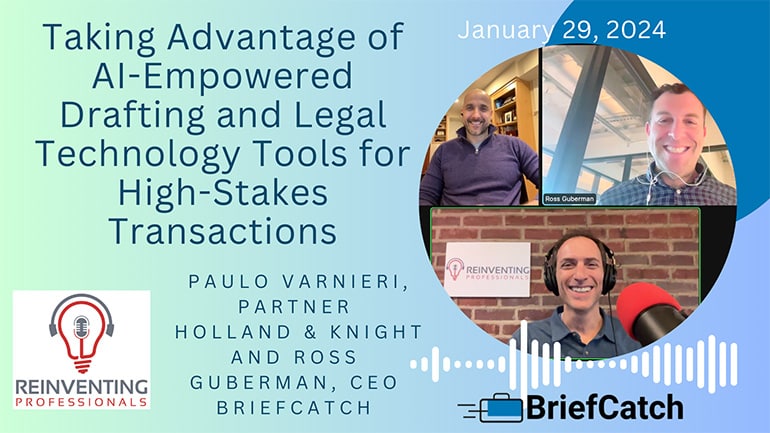Ari Kaplan speaks with Paulo Varnieri, a corporate partner at Holland & Knight, and Ross Guberman, founder and CEO of Law Catch, about using technology to manage an increasingly complex workflow. Law Catch is the developer of BriefCatch, a software platform designed to elevate legal writing, which has recently introduced new generative AI features for lawyers and legal professionals.

Ari Kaplan: Tell us about your background and your practice at Holland & Knight.
Paulo Varnieri: My primary focus is on corporate and M&A transactions, including private equity investments, joint ventures, and project finance, given my background as a general counsel with an aviation infrastructure company.
Ross, you practiced law for several years before pursuing a career focused on legal writing and developing BriefCatch. What inspired that shift?
Ross Guberman: I delivered workshops on different facets of legal writing and, eventually, judicial opinion writing for law firms and courts around the world. People seemed to struggle to apply all of the tips and advice that I shared, given the pressures of their work. In 2017, just as the legal tech sector was heating up, I decided to develop my own software to empower the professionals I serve.
Given the complexity of the deals you manage in your practice, Paulo, how do you incorporate technology to remain current with the developments that arise?
Paulo Varnieri: It is really hard to remain current with all the developments that arise almost monthly or even weekly, but I try to stay abreast of how tools can support my clients and help me provide better guidance and support to them. As a large law firm, I try to use as many resources as I can to provide the best advice most efficiently.
Beyond AI, I view technology as a way to provide better client service. In fact, I always welcome the chance to learn about new tools that can help me serve my clients more effectively. We are in a competitive sector, whether in a large or small law firm, and technology provides a way for a lawyer or a firm to gain a competitive advantage, whether through cost-effective service or efficient advice.
How has BriefCatch evolved to help lawyers navigate this accelerated economic climate?
Ross Guberman: As Paulo noted, competitive pressures do seem higher than ever, particularly with salaries and billing rates rising, as well as increasing levels of attrition. As the practice has evolved, we have transformed into an all-in-one platform or portal for legal writing. Along with getting tens of thousands of potential edits or suggestions, our subscribers receive models of good writing and explanations, with access to different topics that relate to writing and authoritative answers.
This gives law firms a competitive advantage because they can inform clients that they are using these tools to be more efficient and to better allocate their energy to the more complicated aspects of their work. It also gives individual lawyers a competitive advantage because they have more confidence in their writing, which becomes more reliable. BriefCatch also provides training and mentoring opportunities, which are harder to create in a faster-paced and more hybrid work environment. Younger associates prefer learning through technology and can use in-person interaction with senior members of their teams to ask questions and seek advice.
In what ways has the craftsmanship involved with drafting deal documents in these rapidly shifting competitive transactions changed as a result of technology?
Paulo Varnieri: It has changed a lot. Lawyers working on a deal document used to leverage firm precedents in their preparation process and craft something based on that successful example. Now, we have a much broader pool of precedents that include public documents in the SEC’s database, as well as specific clauses that might apply to a particular situation. Lawyers can use these sample provisions as a starting point to work more efficiently. It empowers deal lawyers to enhance their approach to drafting and negotiating crucial agreements.
Given your work with leaders around the world, how do good writing and well-crafted positions affect the outcomes of bet-the-company matters?
Ross Guberman: Paulo referenced understanding what’s market in the transactional space for a given provision and have as your data set something that goes way beyond your firm’s data set. There is something similar in persuasive writing because if you have the right kind of technology, data analysis and expertise, you can adopt the techniques of superior performers in high-stakes cases to increase your chances for success. Technology makes it easier for a typical lawyer to write more like the big stars, which gives them a competitive advantage.
As a former general counsel, do transactional lawyers and law firms need more technology to support their clients?
Paulo Varnieri: Technology is there to help, but firms should adopt tools that will help the firm provide their services more efficiently and cost-effectively for their clients. When I served as general counsel a few years ago, I appreciated working with firms using advanced tools to respond to our needs, as well as for billing.
What new opportunities can law firms realize with artificial intelligence?
Ross Guberman: If you go back to the idea of superior performance as a lawyer and how you can establish what it takes and then impart it, AI is really a godsend as long as you are very careful with how you apply it. You can look for patterns in past performance, such as pleadings that helped win a tough motion or briefs that won difficult Supreme Court cases, and extract patterns that can be converted into actionable guidance. For example, use a specific phrase or don’t describe a case in a certain way.
The other exciting development is in document generation. We have created a product that drafts client alerts for firms based on their source material and a specific partner’s intended audience or client base. That’s a really good example because we are taking something very important for business development, which is not billable and so can be a lower priority, and using AI to accomplish at a high level of quality.
How do you see law firms benefiting from AI-empowered drafting tools for high-stakes transactions going forward?
Paulo Varnieri: There’s no other way, but law firms need to be careful when using generative AI and recognize that those tools are not meant to replace their lawyers. Rather, they can help improve the quality of legal work, such as drafting a brief, petition, or contract. It remains a lawyer’s professional responsibility to ensure the accuracy of the output. That is where the human component comes in because you cannot let a generative AI platform perform a task in isolation. Firms should view it as an important tool that can help make their clients happier with the work the firm is producing.
Ari Kaplan regularly interviews leaders in the legal industry and in the broader professional services community to share perspectives, highlight transformative change, and introduce new technology at ReinventingProfessionals.com.
Listen to his conversation with Paulo Varnieri and Ross Guberman here on Reinventing Professionals.
Read more from Ari Kaplan on Attorney at Work here.
Image © iStockPhoto.com.

Sign up for Attorney at Work’s daily practice tips newsletter here and subscribe to our podcast, Attorney at Work Today.
Illustration ©iStockPhoto.com
Subscribe to Attorney at Work
Get really good ideas every day for your law practice: Subscribe to the Daily Dispatch (it’s free). Follow us on Twitter @attnyatwork.
















